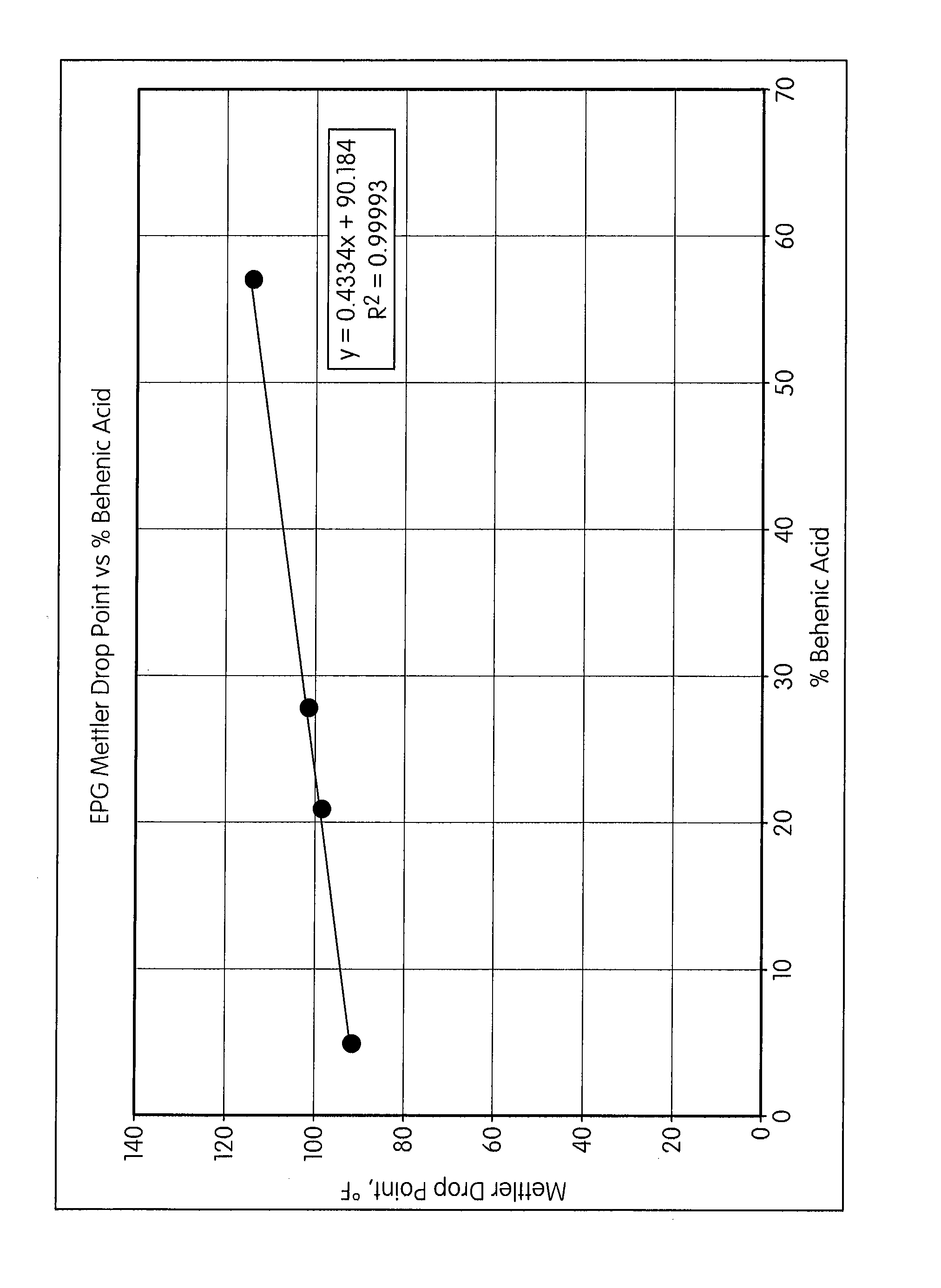Process for producing esterified propoxylated glycerin
a technology of propoxylated glycerin and esterified propoxylated glycerin, which is applied in the direction of fatty acid chemical modification, fatty oil/fat recovery from waste, fatty oil/acid recovery, etc., can solve the problems of reduced shelf life due to off-flavor development, reduce the proportion of unsaturated fatty acid ester groups, and increase the solid fat index of esterified propoxylated glycerin s
- Summary
- Abstract
- Description
- Claims
- Application Information
AI Technical Summary
Benefits of technology
Problems solved by technology
Method used
Image
Examples
example 1
[0040]The process of the present invention may, for example, be carried out as follows. The esterification of propoxylated glycerol (e.g., glycerin which has been reacted with 5 moles of propylene oxide per mole of glycerin) with fatty acids is performed in a 560 L reactor equipped with paratherm heating coils, water cooling coils, an agitator and connected to a vacuum source. The direct esterification reaction (no catalyst is added) is controlled by a gradual increase of temperature (from 70 to 245° C.) during a 7 hour period with simultaneous vacuum increase (from atmospheric to about 10 torr) to remove water (a reaction by-product). Under these parameters about 80-86% esterification is expected during the first 4 hours, while the additional conversion (to 97%) is achieved by extending the reaction time to about 8 hours. The excess of fatty acids used vs. the stoichiometric amount is about 15%, but alternatively could be less (e.g., 5% excess or 10% excess). The fatty acids employ...
example 2
[0044]Where it is desired to prepare an esterified propoxylated glycerin containing an average of 5 oxypropylene groups per molecule and exhibiting a relatively high melting point in the 37 to 45° C. (98.6 to 113° F.) range, it is generally necessary to have such a product contain a high (e.g., 21 to 50 weight %) amount of a long chain saturated fatty acid such as behenic acid in the finished product with substantially all of the remaining fatty acids being stearic and palmitic. In such a case, it may be advantageous to conduct a sequential, 2-step esterification process, particularly if there are equipment limitations relative to distilling excess behenic acid after the reaction.
[0045]In the first step, propoxylated glycerin is reacted with the required amount of behenic acid for the finished product, under the vacuum and the temperature gradients described in Example 1. Once 90-95% of the behenic acid is esterified, the reaction mixture is cooled to 100-120° C., the vacuum broken ...
example 3
[0046]To demonstrate the effect of fatty acid composition on the melting point of esterified propoxylated glycerin, a series of esterified propoxylated glycerins was prepared as shown in Table 1. In each case, the propoxylated glycerin used as a starting material contained approximately five moles of propylene oxide per mole of glycerin (propoxylated glycerin molecular weight=393.2, hydroxyl #=428). A 15% molar excess of fatty acid relative to propoxylated glycerin was used to prepare each batch. A linear correlation between the behenic acid content of the esterified propoxylated glycerin and Mettler drop point was observed (FIG. 1).
[0047]
TABLE 1ExampleExample Example Example 3-13-23-33-4Propoxylated570.2562.8558.1530.6glycerin, gStearic acid,1229.6967.8851.6468.898.8%, gPalmitic acid,—136.6137.3—98%, gBehenic acid,78.6333.6456.9922.990%, gLiquid soybean121.5——73.2oil fatty acids, gTotal fatty acids, 1429.714381445.81464.9gTotal batch1999.92000.82003.81995.5weight, gFatty acidcompos...
PUM
| Property | Measurement | Unit |
|---|---|---|
| weight % | aaaaa | aaaaa |
| temperature | aaaaa | aaaaa |
| temperature | aaaaa | aaaaa |
Abstract
Description
Claims
Application Information
 Login to View More
Login to View More - R&D
- Intellectual Property
- Life Sciences
- Materials
- Tech Scout
- Unparalleled Data Quality
- Higher Quality Content
- 60% Fewer Hallucinations
Browse by: Latest US Patents, China's latest patents, Technical Efficacy Thesaurus, Application Domain, Technology Topic, Popular Technical Reports.
© 2025 PatSnap. All rights reserved.Legal|Privacy policy|Modern Slavery Act Transparency Statement|Sitemap|About US| Contact US: help@patsnap.com


